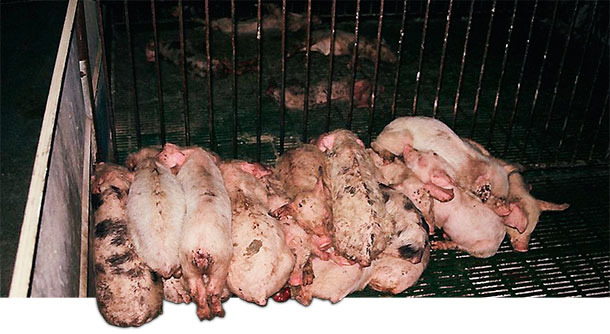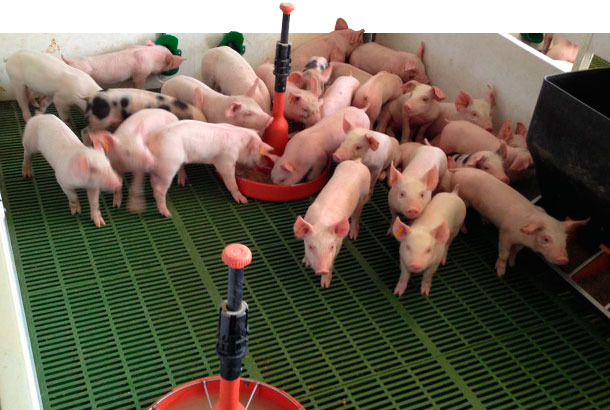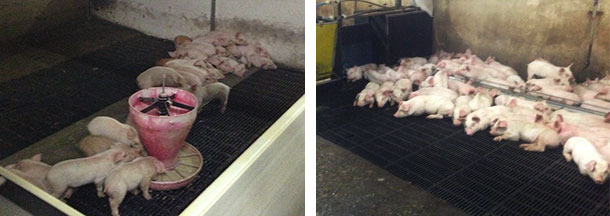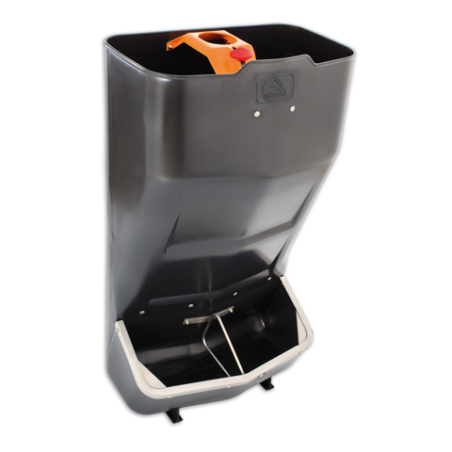The post-weaning phase is perhaps one of the most delicate phases of the pig's productive life. Separation from the dam and feed change at this stage are at the root of many of the problems. The change from a liquid, warm, highly digestible and dam-dependent diet to a solid, cold, less digestible and self-administered (hopper) diet causes a temporary but drastic reduction of food intake that will allow commensal bacteria such as E. coli to express their virulence, causing diarrhoea. Of course, some of the considered predisposing factors —poor hygiene, cold, poor quality diets, presence of other diseases, etc— will favour the onset of diarrhoea.


Picture 1: Piglets with post-weaning diarrhoea.
A proper control of post-weaning diarrhoea (PWD) cannot disregard these predisposing factors, since they are critical points of prevention. We must bear in mind that E. coli is a commensal bacteria that will always be present in every farm:
- The lack of intake during the post-weaning period is considered the main predisposing factor for diarrhoea. This may last a few hours, in a majority of piglets, or up to 48 hours in individual cases. A deficient transition to a solid diet is considered the main cause of diarrhoea. Starter feed should be introduced during lactation. The higher the intake during the lactation phase, the fewer problems we'll have later. Some studies have determined that this reduced intake during the first week post-weaning may increase the risk of diarrhoea up to 30%. An easy and abundant supply of feed and water, as well as keeping the lights on during the first 2-3 days post-weaning, will facilitate intake.

Picture 2: Large supply of feed and water.
- Since the organisms responsible for diarrhoea often remain in the environment, the only effective measures to break the infection cycle include cleaning and disinfection of rooms, and a strict all in-all out management system. Good cleaning and disinfection involves the complete removal of organic material present in the rooms; otherwise, disinfection is rarely effective. We often forget that liquid manure pits and water supply systems are part of the room.
- Cold is a good ally of diarrhoea. Piglets that are cold move less and, consequently, initially reduce their feed intake. The sensation of cold is determined by the combination of temperature, humidity, air velocity and floor type. Rooms with poor insulation have greater condensation and generate draughts, even with correct room temperatures. Such situations are associated with a higher likelihood of diarrhoea because, amongst other things, the normal behaviour of the pig is being altered.

| Picture 3: Cold piglets | Picture 4: Poorly insulated room |
- Understandably, diet can also play a role, hence the importance of digestibility in piglets feeds during the post-weaning phase. Poorly digested substances can lead to intestinal fermentations that will support the growth of E. coli. A few years ago diets for newly weaned piglets had a high protein content because they were intended to achieve maximum growth potential. Today, however, we know that diets with a high protein content can promote post-weaning diarrhoea, hence the current attempt to maintain low protein levels whilst avoiding, at the same time, deficiencies in the various amino acids. Liquid diets, which should favour feed intake of young piglets, have been linked to an increase in diarrhoeal diseases, possibly due to inadequate supply systems.
- Correct control of other infectious processes such as PRRS and circovirus is also important in preventing diarrhoea. Viral circulation affects the proper functioning of the immune system, favouring the emergence of other potential pathogen agents. Correct implementation of prophylactic plans and proper handling of replacements (i.e., their adaptation) and batches will be essential.
Finally, we should mention the routine use of medications. Recent work has shown that the use of active medication against lactobacilli during post-weaning disrupts the balance of the normal intestinal flora, favouring the growth of E. coli. Beta-lactam antibiotics (amoxicillin) should only be used in exceptional cases and not as background therapy, as it frequently happens.






